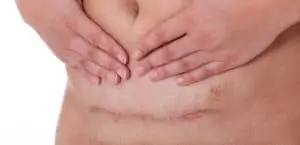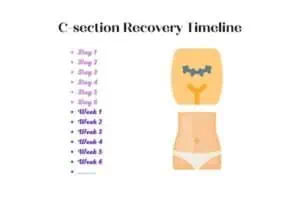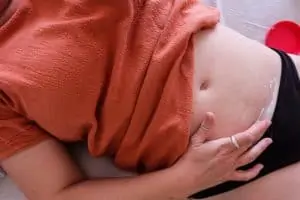Whether you’ve just had your c-section or are planning on one, knowing what to expect the remaining incision to look like can put your fears at ease. And, of course, if something is amiss, knowing will help you get it taken care of quickly before major problems arise.
Remember, a c-section is a pretty major surgery, even though it is a fairly routine procedure. That said, here’s a bit more on what to expect after you go under the knife.
What does a healthy C-section incision look like?
Before I answer what a healthy c-section incision looks like, you need to know that the surgeon will make two cuts. First, it will be an incision to your abdomen, and then they will make a uterine incision which is how they remove your baby. Each of these incisions is just 4 to 6 inches in length, allowing your baby to fit through there.

Most commonly, they will make a horizontal cut in your lower abdomen. They call this the ‘bikini cut’ because it is less visible after you heal. It also tends to hide well under your swimsuit when wearing a two-piece. The other way is the vertical cut which goes from your navel to the pubic line, otherwise known as the ‘classic cut.’
The bikini cut is preferred because it is less painful during healing. However, sometimes it may be necessary to do the classic cut, which will be more painful to recover from and leave behind a more telltale scar.
After the baby is delivered, your doctor will close your uterus using dissolvable stitches. Your body breaks these down naturally with ease, allowing them to dissolve gradually as this incision starts healing.
On the outside, your surgeon will use one of a few different methods to close the skin. Some will use surgical staples as they are fast and easy. However, others will use a surgical needle and thread made of non-dissolvable stitches, which takes a bit longer for them to do.
You’ll have to have stitches or staples removed by your doctor about a week after you have your baby. The good news is you only have to go to the doctor’s office for that.
Other surgeons will use surgical glue. It creates a protective covering that will eventually peel off as your wound heals. You can ask your doctor ahead of your surgery which method they will use to stitch you up and make any preferences clear. You can also discuss the pros and cons.
Now, what does it look like?
Well, it will be hard to see without a mirror; at least it was for me. My belly was still big from having each of my babies. My doctor lined the incision with my previous scar the second time around. Now years later, you can’t even see it.
If you look, you should see a red or pink line there, as if you scratched yourself on something. Eventually, this will fade after some months, taking on a paler and flatter appearance.
If you’re looking at it before you have stitches or staples removed, you may see some of those closures and a little pink or red. This is normal.
What does an infected C-section incision look like?
There is a wide range of normal, but when it comes to an infected c-section incision, chances are, you’re going to know it. It’s important to follow your doctor’s aftercare instructions and ask questions before leaving the hospital. That c-section incision can get infected should bacteria get in there.
Even worse, that bacteria can spread and infect your uterus or abdominal area.
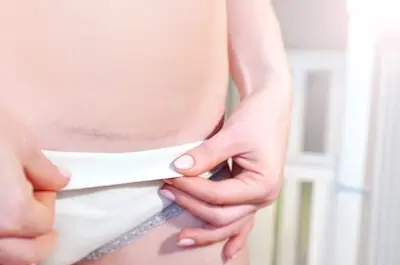
Generally, if you have an infected c-section incision, you will see these symptoms just days after your surgery. While the line will be red or pink, pay attention if you see redness around the entire incision.
Additionally, look for swelling around the incision site or any fluids leaking from that wound. You’ll also likely feel pain or experience heavy bleeding.
Your risk for infection is fairly low, though the risks are much lower if you have a planned c-section. Don’t panic if you have to have an emergency c-section, though! My first one was an emergency, and I had no problems.
There are additional risk factors to consider as well that could increase your risk of c-section incision infection. If you have diabetes that you’re not controlling, are obese, have a penicillin allergy, or have had a previous c-section, you have a greater risk.
I’ve had 2 c-sections, and I was fine! So please don’t worry! If you see anything that concerns you in those first few days, have your doctor check it out.
How to prevent infections of your c-section incision?
When planning a c-section, your doctor may ask you to use a special antibacterial soap before surgery. You should ask before the surgery for sure. But also, do NOT shave! They will shave anything there, and there’s a reason for it – they do not want you to get an infection!
For those who have diabetes, a great way to minimize infection odds is to control your sugars before and after surgery. This is definitely one to discuss with your doctor.
Caring for your incision is imperative. Again, they will not send you on your way home without discussing the care of the c-section incision with you. If anything seems unclear, ask! No one will laugh at you, trust me!
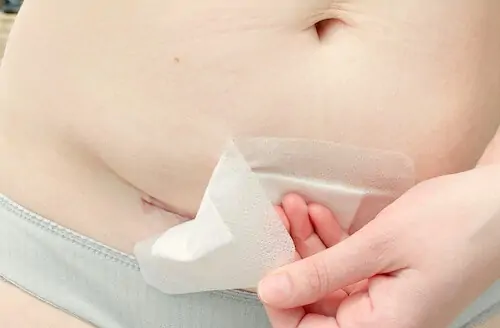
Some tips to help you prevent infection include:
- Cleaning the incision as directed daily
- Changing those bandages as directed daily
- Not putting your baby’s weight right on top of the incision.
- Don’t have sex (or use tampons) for 6 weeks after your c-section (best to wait until your doctor gives you the all-clear at that postpartum checkup)
- Listen to your body – if you feel pain, your doctor may advise you to take OTC pain meds and/or use ice/heat packs to keep you comfortable
- Don’t ever lift anything heavy or overexert yourself (as a rule of thumb, nothing heavier than your newborn should ever be picked up by you during this healing period)
What if I have a c-section infection?
Call your doctor immediately if you’ve seen your incision and have the abovementioned signs. The sooner you get treatment; the better things will be. Your doctor will likely give you antibiotics.
If this happens while you’re still in the hospital, they’ll likely have spotted the trouble and put you on an IV of antibiotics.
All in all, you do not need to worry. Now that you know the signs of normal vs. infected c-section incisions, you can monitor things and get treatment if needed.
Leslie Berry lives with her husband and two young daughters in Los Altos, California, where she loves helping other moms get comfortable with motherhood and embracing the insanity with facts peppered with laughs.
She loves eating too much sushi, exercising, and jamming out on her Fender. Read more about Leslie here.

